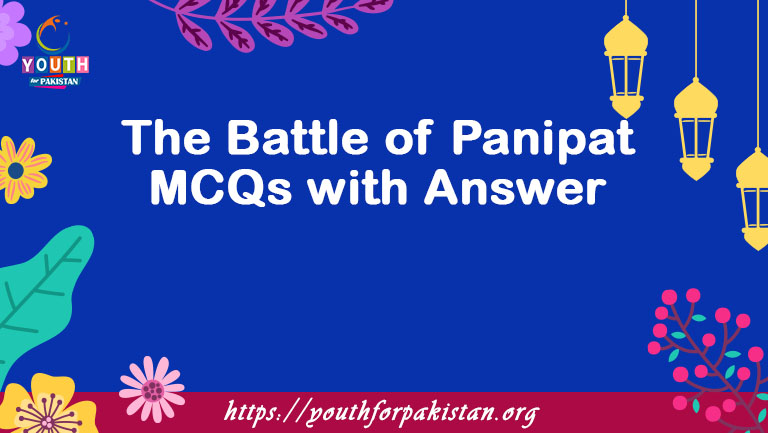The following are The Battle of Panipat MCQs with answers related to Islamic Studies. We have arranged the most important and repeated MCQs in all the competitive examinations. The students can clear their concepts for The Battle of Panipat MCQs online quiz by attempting these.
The Battle of Panipat Online MCQs with Answers
In which year did the Battle of Panipat take place?
A) 1526
B) 1565
C) 1601
D) 1707
A) Akbar
B) Babur
C) Aurangzeb
D) Shah Jahan
A) Chola dynasty
B) Ghaznavid dynasty
C) Tughlaq dynasty
D) Lodi dynasty
A) Ibrahim Lodi
B) Sikandar Lodi
C) Bahlol Lodi
D) Daulat Khan Lodi
A) Delhi
B) Agra
C) Panipat
D) Jaipur
A) To establish trade routes
B) To convert people to Islam
C) To expand his empire
D) To seek refuge from enemies
A) Naval warfare
B) Guerilla warfare
C) Artillery warfare
D) Cavalry warfare
A) Babur
B) Akbar
C) Aurangzeb
D) Ahmad Shah Durrani
A) 1526
B) 1565
C) 1601
D) 1761
A) Ahmad Shah Durrani (Ahmad Shah Abdali)
B) Sher Shah Suri
C) Shah Jahan
D) Akbar
A) Maratha expansion into North India
B) Mughal-Afghan rivalry
C) British colonial ambitions
D) Portuguese interference in Indian affairs
A) Maurya dynasty
B) Chola dynasty
C) Maratha Empire
D) Vijayanagara Empire
A) Victory and expansion of their empire
B) Defeat and decline of their power
C) Truce with the Mughals
D) Alliance with Ahmad Shah Durrani
A) Raghunath Rao
B) Madhavrao I
C) Nana Saheb
D) Sadashivrao Bhau
A) It played a decisive role in Babur’s victory.
B) It had no significant impact on the battle.
C) It favored the Lodi dynasty.
D) It led to a stalemate.
A) It marked the beginning of the decline of the Mughal Empire.
B) It solidified Mughal rule over India.
C) It had no significant impact on the Mughals.
D) It resulted in the expansion of the Mughal Empire.
A) To establish trade routes
B) To convert people to Islam
C) To expand his empire
D) To seek refuge from enemies
A) Superior artillery
B) Cavalry tactics
C) Diplomatic negotiations
D) Disease among Maratha forces
A) It marked the zenith of Maratha power.
B) It had no significant impact on the Marathas.
C) It led to the decline of the Maratha Empire.
D) It resulted in Maratha expansion into North India.
A) He led the Maratha forces to victory.
B) He negotiated a truce with the Marathas.
C) He commanded the Afghan forces to victory.
D) He had no involvement in the battle.
A) Akbar
B) Babur
C) Aurangzeb
D) Shah Jahan
A) Economic instability
B) Religious conflicts
C) Invasions and external pressures
D) Political corruption
A) Baji Rao I
B) Madhavrao I
C) Nanasaheb Peshwa
D) Balaji Baji Rao
A) It played a decisive role in Ahmad Shah Durrani’s victory.
B) It had no significant impact on the battle.
C) It favored the Marathas.
D) It led to a stalemate.
A) It marked the resurgence of the Mughal Empire.
B) It resulted in the dissolution of the Mughal Empire.
C) It had no significant impact on the Mughals.
D) It led to the establishment of British rule in India.
A) Religious conflicts
B) Maratha expansion into North India
C) Mughal-Afghan rivalry
D) Portuguese interference in Indian affairs
A) Akbar
B) Babur
C) Aurangzeb
D) Shah Jahan
A) Victory and expansion of their empire
B) Defeat and decline of their power
C) Truce with the Mughals
D) Alliance with Babur
A) Naval warfare
B) Guerilla warfare
C) Artillery warfare
D) Cavalry warfare
A) Akbar
B) Babur
C) Aurangzeb
D) Shah Jahan
A) Religious conflicts
B) Maratha expansion into North India
C) Mughal-Afghan rivalry
D) British colonial ambitions
A) Akbar
B) Babur
C) Ahmad Shah Durrani
D) Shah Jahan
A) It marked the zenith of Maratha power.
B) It had no significant impact on the Marathas.
C) It led to the decline of the Maratha Empire.
D) It resulted in Maratha expansion into North India.
A) Baji Rao I
B) Madhavrao I
C) Nanasaheb Peshwa
D) Balaji Baji Rao
A) Superior artillery of the Afghan forces
B) Lack of cavalry tactics
C) Diplomatic negotiations with the Mughals
D) Disease among Maratha forces
A) Victory and expansion of their empire
B) Defeat and decline of their power
C) Truce with the Mughals
D) Alliance with Ahmad Shah Durrani
A) Superior artillery
B) Cavalry tactics
C) Diplomatic negotiations
D) Disease among Maratha forces
A) Akbar
B) Babur
C) Aurangzeb
D) Shah Jahan
A) Economic instability
B) Religious conflicts
C) Invasions and external pressures
D) Political corruption
A) Baji Rao I
B) Madhavrao I
C) Nanasaheb Peshwa
D) Balaji Baji Rao
A) It played a decisive role in Ahmad Shah Durrani’s victory.
B) It had no significant impact on the battle.
C) It favored the Marathas.
D) It led to a stalemate.
A) It marked the resurgence of the Mughal Empire.
B) It resulted in the dissolution of the Mughal Empire.
C) It had no significant impact on the Mughals.
D) It led to the establishment of British rule in India.
A) Religious conflicts
B) Maratha expansion into North India
C) Mughal-Afghan rivalry
D) Portuguese interference in Indian affairs
A) Akbar
B) Babur
C) Aurangzeb
D) Shah Jahan
A) Victory and expansion of their empire
B) Defeat and decline of their power
C) Truce with the Mughals
D) Alliance with Babur
A) Naval warfare
B) Guerilla warfare
C) Artillery warfare
D) Cavalry warfare
A) Akbar
B) Babur
C) Aurangzeb
D) Shah Jahan
A) Religious conflicts
B) Maratha expansion into North India
C) Mughal-Afghan rivalry
D) British colonial ambitions
A) Akbar
B) Babur
C) Ahmad Shah Durrani
D) Shah Jahan
A) It marked the zenith of Maratha power.
B) It had no significant impact on the Marathas.
C) It led to the decline of the Maratha Empire.
D) It resulted in Maratha expansion into North India.









